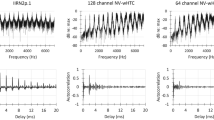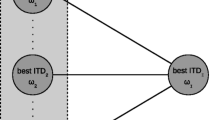Abstract
Harmonicity serves to group together frequencies from a single source to a perceived auditory object. The peripheral auditory system may exploit either spectral cues resulting in a specific spatial pattern of excitation or temporal cues that are due to the interaction of frequency components in the complex to evaluate whether a component does not belong to a harmonic complex, i.e., is mistuned. Which cues are useful for mistuning detection may depend on the anatomical and physiological constraints in the peripheral auditory system. Here we compare the perception of frequency shifts in harmonic complexes (i.e., mistuning) and in pure tones across species. Mongolian gerbils and birds are superior to humans in detecting small amounts of mistuning in sine phase harmonic complexes. This difference is reduced in the detection of mistuning in random phase harmonic complexes (but not in harmonic complexes with “frozen random phase”). Humans are superior to birds and gerbils in detecting pure-tone frequency shifts. The results suggest that species with a short cochlea and only few hair cells per critical band tend to rely more on temporal fine structure in the analysis of mistuning of components in harmonic complexes whereas excitation patterns may play a larger role in humans with a much longer cochlea. For the analysis of pure-tone frequency shifts, excitation patterns appear to play a more prominent role in all species. Exemplary neurophysiological data obtained in starlings support this view.
Access this chapter
Tax calculation will be finalised at checkout
Purchases are for personal use only
Similar content being viewed by others
References
Buus S, Klump GM, Gleich O, Langemann U (1995) An excitation-pattern model for the starling (Sturnus vulgaris). J Acoust Soc Am 98:112–124
de Cheveigné A (1998) Cancellation model of pitch perception. J Acoust Soc Am 103:1261–1271
Dooling RJ, Saunders JC (1975) Hearing in the parakeet (Melopsittacus undulatus): absolute thresholds, critical ratios, frequency difference limens, and vocalizations. J Comp Physiol Psychol 88:1–20
Duifhuis H, Willems LF, Sluyter RJ (1982) Measurement of pitch in speech: an implementation of Goldstein’s theory of pitch perception. J Acoust Soc Am 71:1568–1580
Fay RR (1992) Structure and function in sound discrimination among vertebrates. In: Webster D, Fay RR, Popper A (eds) The evolutionary biology of hearing. Springer, New York, pp 229–263
Gleich O, Manley GA (1988) Quantitative morphological analysis of the sensory epithelium of the starling and pigeon basilar papilla. Hear Res 34:69–85
Gockel HE, Carlyon RP, Plack CJ (2004) Across-frequency interference effects in fundamental frequency discrimination: questioning evidence for two pitch mechanisms. J Acoust Soc Am 116:1092–1104
Goldstein JL (1973) An optimum processor theory for the central formation of the pitch of complex tones. J Acoust Soc Am 54:1496–1516
Greenwood DD (1990) A cochlear frequency-position function for several species - 29 years later. J Acoust Soc Am 87:2592–2605
Hartmann WM, McAdams S, Smith BK (1990) Hearing a mistuned harmonic in an otherwise complex tone. J Acoust Soc Am 88:1712–1724
Houtsma AJ, Smurzynski J (1990) Pitch identification and discrimination for complex tones with many harmonics. J Acoust Soc Am 87:304–310
ISO 389-7 (1996) Acoustics-Reference zero for the calibration of audiometric equipment - part 7: Reference threshold of hearing under free-field and diffuse-field listening conditions
Joris PX, Schreiner CE, Rees A (2004) Neural processing of amplitude-modulated sounds. Physiol Rev 84:541–577
Kittel M, Wagner E, Klump GM (2002) An estimate of the auditory-filter bandwidth in the Mongolian gerbil. Hear Res 164:69–76
Klinge A, Klump GM (2009) Frequency difference limens of pure tones and harmonics within complex stimuli in Mongolian gerbils and humans. J Acoust Soc Am 125:304–314
Klinge A, Klump GM (submitted) Mistuning detection and onset asynchrony in harmonic complexes in Mongolian gerbils
Klump GM, Groß S (submitted) Detection of frequency shifts and mistuning in complex tones in the European starling
Köppl C (1997) Phase locking to high frequencies in the auditory nerve and cochlear nucleus magnocellularis of the barn owl, Tyto alba. J Neurosci 17:3312–3321
Licklider JC (1951) A duplex theory of pitch perception. Experientia 7:128–134
Lohr B, Dooling RJ (1998) Detection of changes in timbre and harmonicity in complex sounds by zebra finches (Taeniopygia guttata) and budgerigars (Melopsittacus undulatus). J Comp Psychol 112:36–47
Manley GA, Schwabedissen G, Gleich O (1993) Morphology of the basilar papilla of the budgerigar Melopsittacus undulatus. J Morphol 218:153–165
Meddis R, Hewitt MJ (1991a) Virtual pitch and phase sensitivity of a computer model of the auditory periphery. I: Pitch identification. J Acoust Soc Am 89:2866–2882
Meddis R, Hewitt MJ (1991b) Virtual pitch and phase sensitivity of a computer model of the auditory periphery. II: phase sensitivity. J Acoust Soc Am 89:2883–2894
Meddis R, O’Mard L (1997) A unitary model of pitch perception. J Acoust Soc Am 102:1811–1820
Moore BC (1973) Frequency difference limens for short-duration tones. J Acoust Soc Am 54:610–619
Moore BC, Glasberg BR, Peters RW (1984) Frequency and intensity difference limens for harmonics within complex tones. J Acoust Soc Am 75:550–561
Moore BC, Peters RW, Glasberg BR (1985) Thresholds for the detection of inharmonicity in complex tones. J Acoust Soc Am 77:1861–1867
Moore BC, Glasberg BR, Peters RW (1986) Thresholds for hearing mistuned partials as separate tones in harmonic complexes. J Acoust Soc Am 80:479–483
Müller M (1996) The cochlear place-frequency map of the adult and developing Mongolian gerbil. Hear Res 94:148–156
Plassmann W, Peetz W, Schmidt M (1987) The cochlea in Gerbilline rodents. Brain Behav Evol 30:82–101
Pressnitzer D, Winter IM, Patterson RD (2000) The responses of single units in the ventral cochlear nucleus of the guinea pig to damped and ramped sinusoids. Hear Res 149:155–166
Ryan A (1976) Hearing sensitivity of the Mongolian gerbil, Meriones unguiculatis. J Acoust Soc Am 59:1222–1226
Sek A, Moore BC (1995) Frequency discrimination as a function of frequency, measured in several ways. J Acoust Soc Am 97:2479–2486
Wright A, Davis A, Bredberg G, Ulehlova L, Spencer H (1987) Hair cell distributions in the normal human cochlea. Acta Otolaryngol Suppl 444:1–48
Author information
Authors and Affiliations
Corresponding author
Editor information
Editors and Affiliations
Rights and permissions
Copyright information
© 2010 Springer Science+Business Media, LLC
About this paper
Cite this paper
Klinge, A., Itatani, N., Klump, G.M. (2010). A Comparative View on the Perception of Mistuning: Constraints of the Auditory Periphery. In: Lopez-Poveda, E., Palmer, A., Meddis, R. (eds) The Neurophysiological Bases of Auditory Perception. Springer, New York, NY. https://doi.org/10.1007/978-1-4419-5686-6_43
Download citation
DOI: https://doi.org/10.1007/978-1-4419-5686-6_43
Published:
Publisher Name: Springer, New York, NY
Print ISBN: 978-1-4419-5685-9
Online ISBN: 978-1-4419-5686-6
eBook Packages: Biomedical and Life SciencesBiomedical and Life Sciences (R0)




